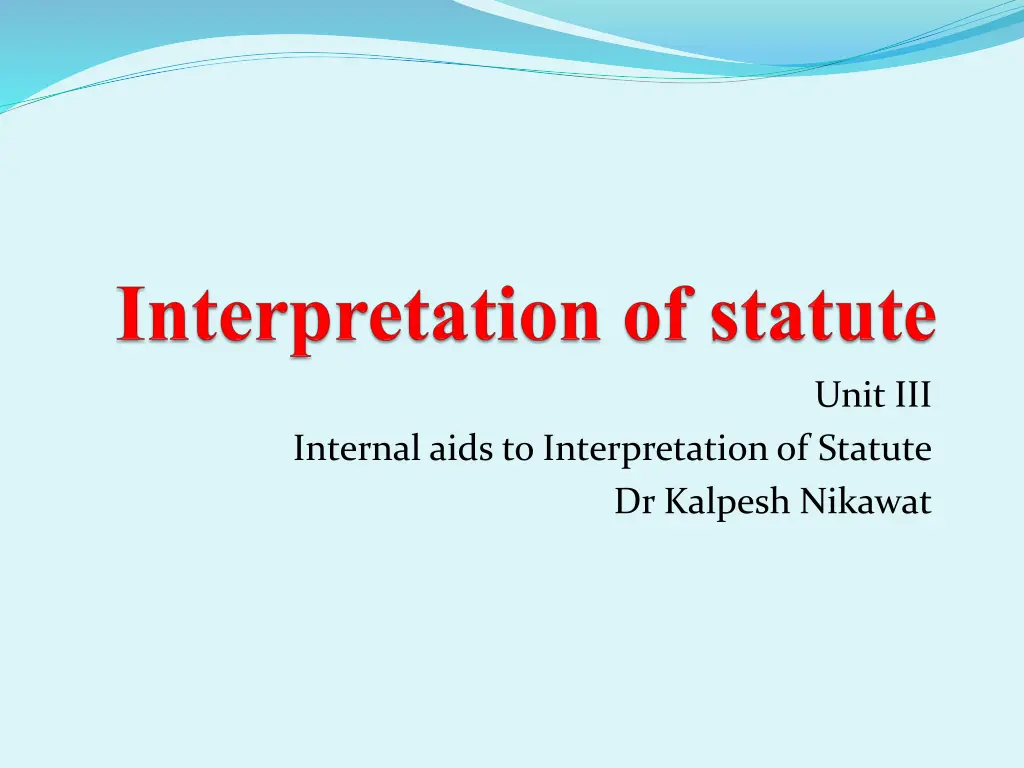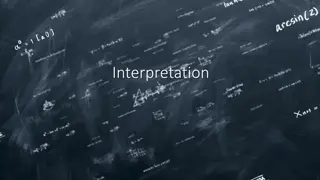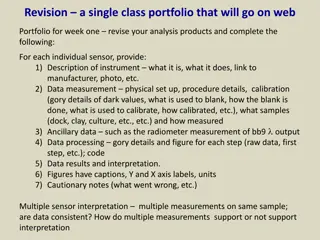
Internal Aids to Interpretation of Statutes Explained with Examples
Learn about internal aids for interpreting statutes, including long titles, preambles, and more. Understand the difference between internal and external aids with practical examples. Explore the significance of short titles and long titles in legal interpretation. Discover how the preamble serves as a tool for understanding the main objectives of an Act.
Download Presentation

Please find below an Image/Link to download the presentation.
The content on the website is provided AS IS for your information and personal use only. It may not be sold, licensed, or shared on other websites without obtaining consent from the author. If you encounter any issues during the download, it is possible that the publisher has removed the file from their server.
You are allowed to download the files provided on this website for personal or commercial use, subject to the condition that they are used lawfully. All files are the property of their respective owners.
The content on the website is provided AS IS for your information and personal use only. It may not be sold, licensed, or shared on other websites without obtaining consent from the author.
E N D
Presentation Transcript
Unit III Internal aids to Interpretation of Statute Dr Kalpesh Nikawat
Types of interpretation aids Broadly two interpretation aids are available:- (1) Internal aids - which are existing in the Statutes itself (2) External aids - which are found outside the Statutes. An 'Aid' is a device that helps or assists. While performing the function of interpreting provision of a statute, the court can take help from within the statute or even outside the statute. The former is called 'internal aids' and the latter is called 'external aids'.
Internal aids to interpretation Internal aids means those aids which are available in the statute itself, court can interpret the statute by employing such aids which are as follows: Internal aids mean those materials which are available in the statute itself, though they may not be part of enactment. These internal aids include, long title, preamble, headings, marginal notes, illustrations, punctuation, proviso, schedule, transitory provisions, etc. When internal aids are not adequate, court has to take recourse to External aids. External Aids may be parliamentary material, historical background, reports of a committee or a commission, official statement, dictionary meanings, foreign decisions, etc. Title of the statute There are basically two types of title- Short Title , Long Title I. Short Title The short title of the Act is only its name which is given solely for the purpose of reference and identification. Short title is mention under Section 1 of the Acts and ends with the year of passing of the Act. Example- Section 1 of CPC says, This Act may be cited as Code of Civil Procedure, 1908.' Section 1 of Indian contract Acts says, This Act may be called as Indian Contract Act, 1872. , 1860 1872 ;
Internal aids to interpretation II. Long Title The long title is mention under certain acts whose purpose is to give a general description about the object of the act. However, it is not considered as a conclusive aid to interpretation of statutes as it doesn't resolve ambiguity arising in words or expression under statutory provision but only provide a general idea of the act. Example- The long title of Cr.P.C. says, An act to consolidate and amend the laws relating to the criminal procedure. Also, the long title of CPC says, An act to consolidate and amend the laws relating to the procedure of the courts of civil judicature. In Re Kerala Education bill, the Supreme Court held that the policy and purpose may be deduced from the long title and the preamble. In Manohar Lal v State of Punjab, Long title of the Act is relied as a guide to decide the scope of the Act. , , , , 1973 , , ,1908
Internal aids to interpretation Preamble Preamble is a tool for internal aid to interpretation as it contains the main objects and reasons of the Act. The rule of interpretation of preamble is that when a language of an enactment is clear and unambiguous, the preamble has no part to play but if more than one interpretation is possible, a help can be taken from preamble to ascertain the true meaning of the provision. The preamble is mention on the very first page of the act but modern acts doesn't pass with preamble which is declining its importance. State of West Bengal v. Anwar Ali AIR 1952 SC 75, the constitutionality of Section 5 of the West Bengal special courts act, 1950 was challenged on the grounds of violative of Article 14 of the constitution as the provision in the act authorize state government to select a particular case which deserved to be tried by special courts having special procedure. The Supreme Court take help of the preamble of the said Act and held that state government has discretion to choose such cases. In Kashi Prasad v State, the court held that even though the preamble cannot be used to defeat the enacting clauses of a statute, it can be treated as a key for the interpretation of the statute. , , 1860 -
Internal aids to interpretation Marginal notes Marginal notes are inserted at the side of the sections in an act which express the effect of the section but they are not part of statute. They are also known as Side notes and are inserted by drafters and not legislators. The rule of interpretation is that in olden times a help is used to be taken from marginal notes when the clear meaning of the provision is in doubt but as per modern view of the court, marginal notes doesn't have any role to play because either they are inserted by legislators nor does they form the part of the statute. However, for interpreting constitution many times marginal notes are referred because they are made by constituent assembly. In Wilkes v Goodwin, the Court held that the side notes are not part of the Act and hence marginal notes cannot be referred. Bengal Immunity Company v. State of Bihar AIR 1955 SC 661, the Supreme Court held that the marginal notes of Article 286 is the part of the Constitution of India which talks about Restrictions as to imposition of the tax on the sale or purchase of goods therefore, it could be relied on to furnish a clue to the purpose and meaning of the article 94 , 1973 110
Internal aids to interpretation Headings Headings are prefixed to sections or a group or set of sections. These headings have been treated by courts as preambles to those sections or sets of sections. The rule of interpretation is that the heading can't control the plain words of the provision but if after the plain reading of the section more than one meaning is possible, only then the court may seek guidance from the headings. Tolley v. Giddings , interpretation of Section 217 of Road Traffic Act was in question which provides that a person could be held liable of an offence if he allowed himself to be driven away in a motor vehicle without the consent of its master. The heading of the provision is Miscellaneous and general' and sub heading is Penalization of taking motor vehicle without authority'. The court held that headings to the section clearly explain the intention of the legislature and thus the passenger would be held liable of an offence. In Krishnaih V. State of A.P. AIR 2005 SC 10 it was held that headings prefixed to sections cannot control the plain words of the provisions. Only in the case of ambiguity or doubt, heading or sub- heading may be referred to as an aid in construing provision. In Durga Thathera v Narain Thathera, the court held that the headings are like a preamble which helps as a key to the mind of the legislature but do not control the substantive section of the enactment. , , 299 377 Tolley v. Giddings (1994) 2 QB 354 1960 217(1) is Miscellaneous and general' and sub heading is Penalization of taking motor vehicle without authority
Internal aids to interpretation Explanation inserted The meaning of a particular provision and to remove doubts which might creep up if the explanation The purpose of explanations are to explain the meaning and intention of act, to clarify in case of obscurity or vagueness and to provide additional support to the object However, it doesn't expand or curtail the meaning of the provision but only tries to remove uncertainty and in the case of conflict between explanation and main section, the duty of the court is to harmonize the two. explanations are with the purpose of explaining the had not been inserted. of the act. Example- section 108 of IPC defines the word abettor' which has five explanation attach to it. 108
Internal aids to interpretation Definition or Interpretation clause It define certain words used elsewhere in the body of statute with the purpose to avoid the necessity of frequent repetitions in describing the subject matter and extend the natural meaning of some words as per the statute. It also define intention of the legislature in respect of words mention in statute and avoid confusion. The rule of interpretation is that whenever the words means or means and include' are used in definition, it makes the definition exhaustive and don't allow to interpret the definition widely but if the word includes' is used in the definition it provide widest interpretation possible to the definition or enlarge the ordinary meaning of the word. However, if the definition clause will result in an absurdity, the court will not apply such definitions and the definition clause of one act can't be used to explain same word used in another statute except in the case of statutes in pari materia. Mahalaxmi Oils Mils v. State of A.P AIR 1989 SC 335, interpretation of word tobacco was in question which said tobacco means any form of tobacco whether cured or uncured or manufactured or not and includes leaf stalks and steams of tobacco plant. The SC held that the definition is exhaustive and refused to include tobacco seeds under the definition of tobacco. 1872 3 2
Internal aids to interpretation Illustration Illustration are appended to a section of a statute with a view to illustrating the law explained in the provision. Such illustration manifest the intention of the legislature and can be referred in the case of ambiguity or repugnancy. However, the court emphasis through various judgments that it doesn't explain the whole principle explain in the section through illustration nor does it curtail the ambit of the section. In the case of repugnancy between section and illustration, section will prevail. Example- Section 378 of theft in IPC has 16 illustrations attached to it. In Mahesh Chandra Sharma V.Raj Kumari Sharma, (AIR 1996 SC 869), it was held that illustrations are parts of the Section and help to elucidate the principles of the section. , 378 ( ) ( ) 16 ,
Internal aids to interpretation Punctuation Punctuation are put in the form of colon, semi colon, comma, full stop, dash, hyphen, brackets etc In earlier times statutes are passed without punctuations and therefore, the courts were not concerned with looking at punctuations but in modern times statutes are passed with punctuations. The rule of interpretation is that while interpreting the provision in punctuated form, if court feels repugnancy or ambiguity the court shall read the whole provision without any punctuation and if the meaning is clear will so interpret it without attaching any importance.
Internal aids to interpretation Schedules Schedule are the part of statutes which are mentioned at the end of the act. It contains details prescribe form of working out policies and contains subjects in the form of lists. In the case of clash between schedule and the main body of an act, the main body shall prevail. Example- Article 1 of the constitution provides that India shall be union of states and in schedule 1 name of the states with its territories are mention. 7 3
Internal aids to interpretation Saving Clause Saving Clause are generally appended in cases of repeal and reenactment of a new statute. It is inserted in the repealing statute. By this the rights already created under repealed enactment are not disturbed nor are new rights created by it. In the case of clash between the main part of statute and a saving clause, the saving clause has to be rejected.
Internal aids to interpretation Proviso The proviso to a section has the natural presumption that enacting part of the section would have included the subject matter of the proviso. The proviso serve four different purposes- qualify or exempt certain provision, provide mandatory condition to be fulfilled by to make enactment workable, act as optional addenda and become integral part of the enactment. The rule of interpretation of proviso is that it can neither nullify the implication of main enactment nor can enlarge the scope of main enactment and can only be referred in case of ambiguity in the section. In case of conflict between main enactment and proviso, it must be harmoniously construct or in the view of many jurist proviso will prevail as it is the last intention of the legislature. Example-Article 16(4) is considered as proviso of Article 16(1) held in T. Devadasan v. Union of India . 120 - AIR 1964 SC 179 16 4 1
Internal aids to interpretation Exception Exception are generally added to an enactment with the purpose of exempting something which would otherwise fall within the ambit of the main provision. In case of repugnancy between exception and main enactment, the latter must be relied upon. However, in many cases exceptions are relied being the last intention of legislature. Example: Section 300 of IPC has five exceptions attached to it. , 300 5






















